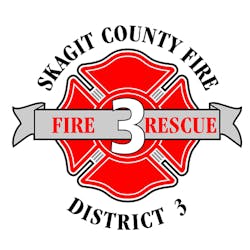WA Fire Districts Wait on CA Wildfire Aid
Two Skagit County fire districts are awaiting reimbursement from the state of Washington after sending firefighters and equipment to California to help battle summer wildfires.
In August, fire districts 3 and 14 — which serve the areas of Conway and Alger, respectively — sent crews to battle some of California’s deadly wildfires. The districts are waiting to be reimbursed $75,000 each in personnel costs.
That delay has local fire chiefs worried.
“That’s like 20 percent of our budget,” District 3 Chief Mike Ray said. “That’s $75,000 that we didn’t expect to spend.”
At issue is a contract between the state’s Department of Emergency Management and local fire departments that agreed, through a federal mutual aid agreement, to send help to other states in case of emergency.
Under the aid agreement, states that have a declared a state of federal emergency can request assistance from other states.
The state requesting aid — in this case California — then reimburses the state that sent the aid. That state is then responsible for reimbursing the responding fire departments.
In order to participate in the aid agreement, departments must develop a plan that includes personnel costs and submit it to the state through a regional coordinator, said Snohomish County Fire District 7 Assistant Chief Eric Andrews, the regional coordinator for Island, Skagit, Snohomish, San Juan and Whatcom counties.
Once a plan is submitted, Andrews said there is no formal process regarding approval or denial — so departments send aid when requested.
“It’s never been a conflict in the past,” Skagit County Fire District 14 Chief Dave Skrinde said of sending aid. “Skagit County, we’re small, but we still have departments that are willing to send resources to help out.”
This year was different.
Andrews said he submitted the regional contracts in May and they were rejected in October — long after departments such as his and districts 3 and 14 in Skagit County had sent crews to California.
The submitted plan, he said, had firefighters getting paid “portal to portal” — essentially from the time they leave their home stations to the time they return.
Firefighters who get paid “portal to portal” are always on call and expected to remain on scene and in uniform, Andrews said.
That method is not, however, how firefighters from Washington are paid when they respond to fires within the state, he said.
Firefighters responding to in-state fires are paid for the time it takes to drive to the scene and for the about 12- to 14-hour shift they work, but they are not paid for “rest time,” during which time they are not required to stay on call.
The state has decided that payment method should be implemented for out-of-state fire response as well, Andrews said.
“Any time we leave the state, we expect to get paid portal to portal,” Andrews said. “We think when our firefighters are going down there ... they should be paid like everybody else.”
Progress on reimbursements is being made, Andrews said.
After working with the state, he said he has resubmitted the plan and expects the districts to receive their money by March.
“We’ll eventually get paid, but we’re not getting paid in a timely manner,” Skrinde said.
Without the assurance of timely reimbursement, some departments may stop sending assistance. That is what districts 3 and 14 did in November, when California requested assistance battling the deadly Camp Fire.
“(That) only hurts other states,” Skrinde said of not responding. “It bothers me a lot, because that’s how we’re programmed. If I had people that were available and resources that were available, I’d send them anywhere.”
In 2017, the Mount Vernon Fire Department sent assistance to California, but because of delays in reimbursement, the department did not send assistance in 2018, Chief Bryan Brice said.
Brice said the decision to not send assistance wasn’t the decision he wanted to make, but it was necessary.
“I have to be (OK with it),” he said. “I’m OK with it from the standpoint that I have a duty to the city.”
Ray agreed, saying that although there is a financial benefit to the departments in the form of a $30,000 “rental” fee for each fire engine sent to a fire, that benefit may not outweigh the uncertainty.
“The money’s great for the taxpayers, but the risk isn’t worth the reward,” he said.
Districts 3 and 14 are still waiting to receive the $30,000 from the state, on top of the about $75,000 in personnel costs.
Not sending aid, Brice said, might set a dangerous precedent.
“Our neighbors in California were out of resources,” Brice said. “If we don’t help them, what makes us think they’re going to help us when we have our need?”
If the departments could receive an assurance that they would be paid in a timely manner, Ray said he would be willing to send crews.
Going forward, Andrews said the departments and the state will have a contract finalized before each fire season.
“I have no problem as a department sending them down,” he said. “I just want to make sure that we have a clear understanding of what the expectations are.”
———
©2019 the Skagit Valley Herald (Mount Vernon, Wash.)
Visit the Skagit Valley Herald (Mount Vernon, Wash.) at www.goskagit.com
Distributed by Tribune Content Agency, LLC.
